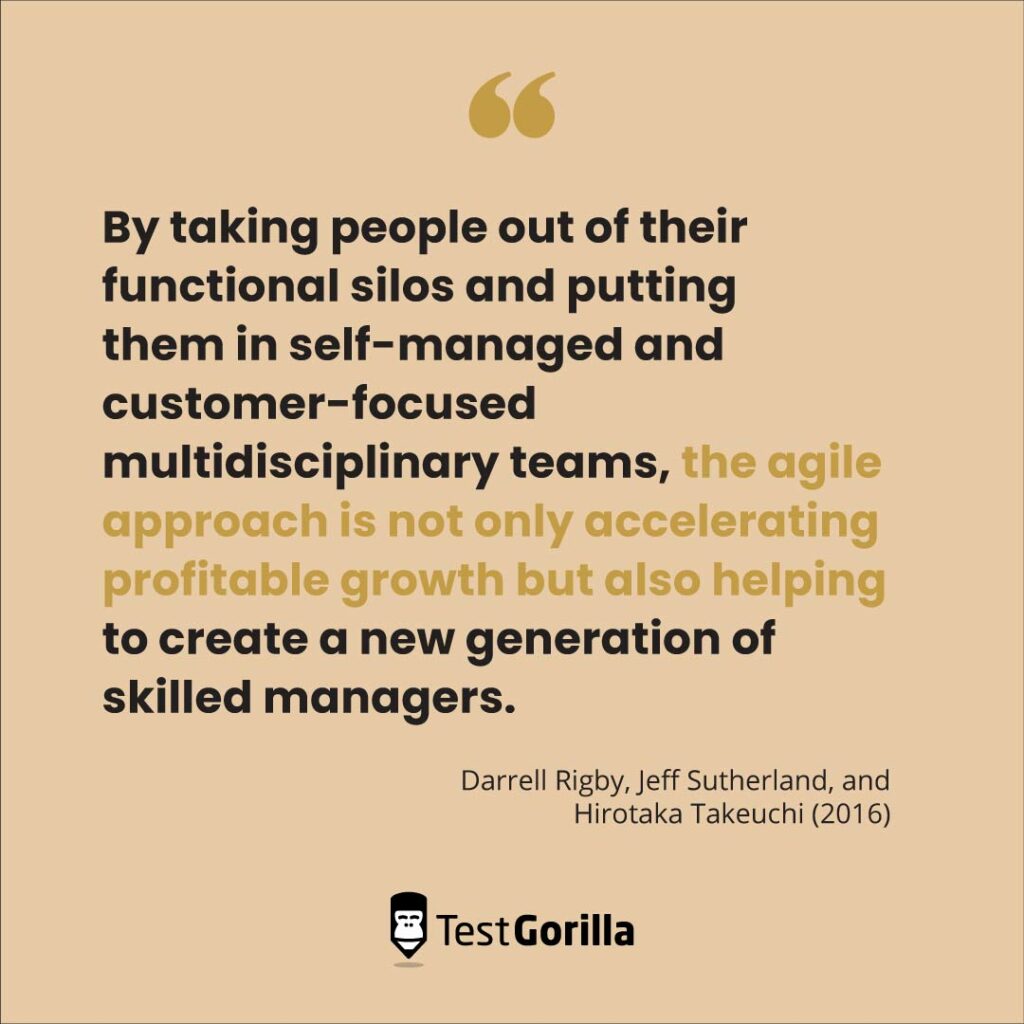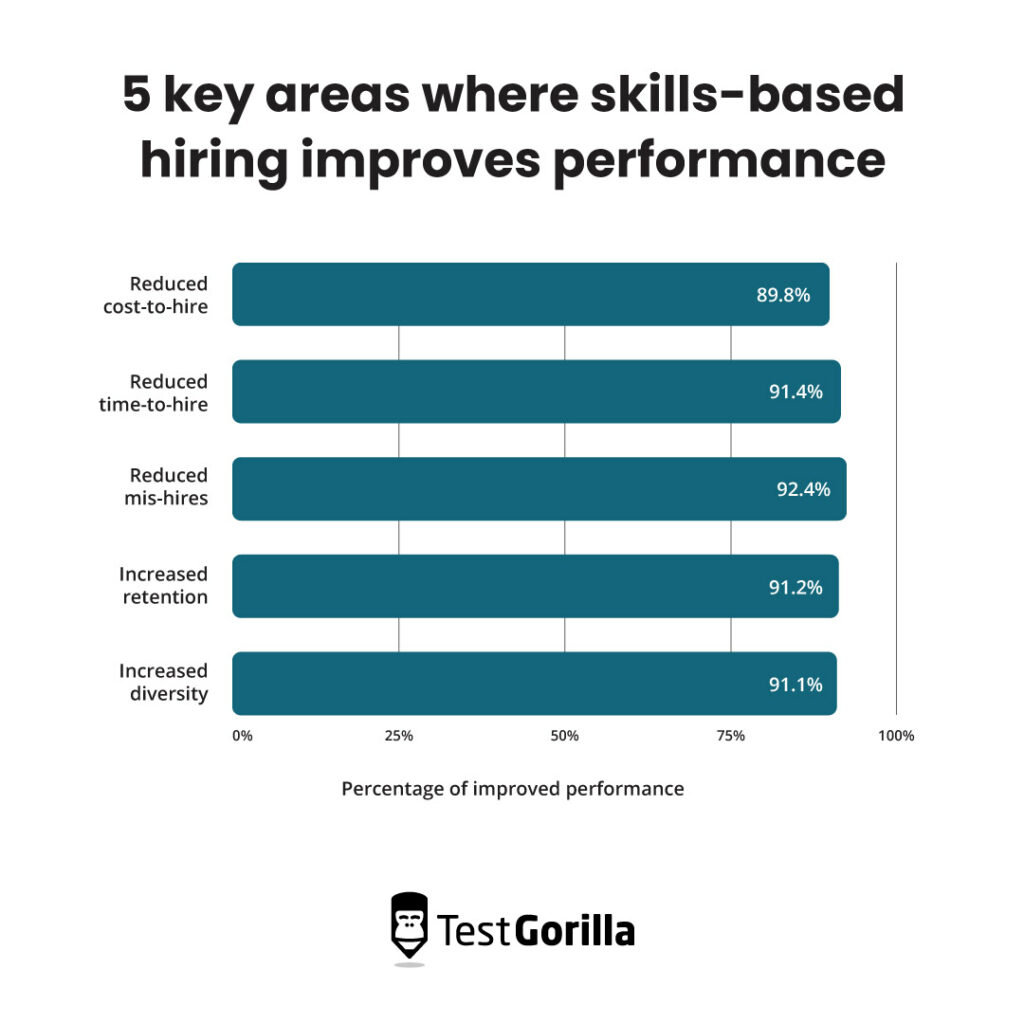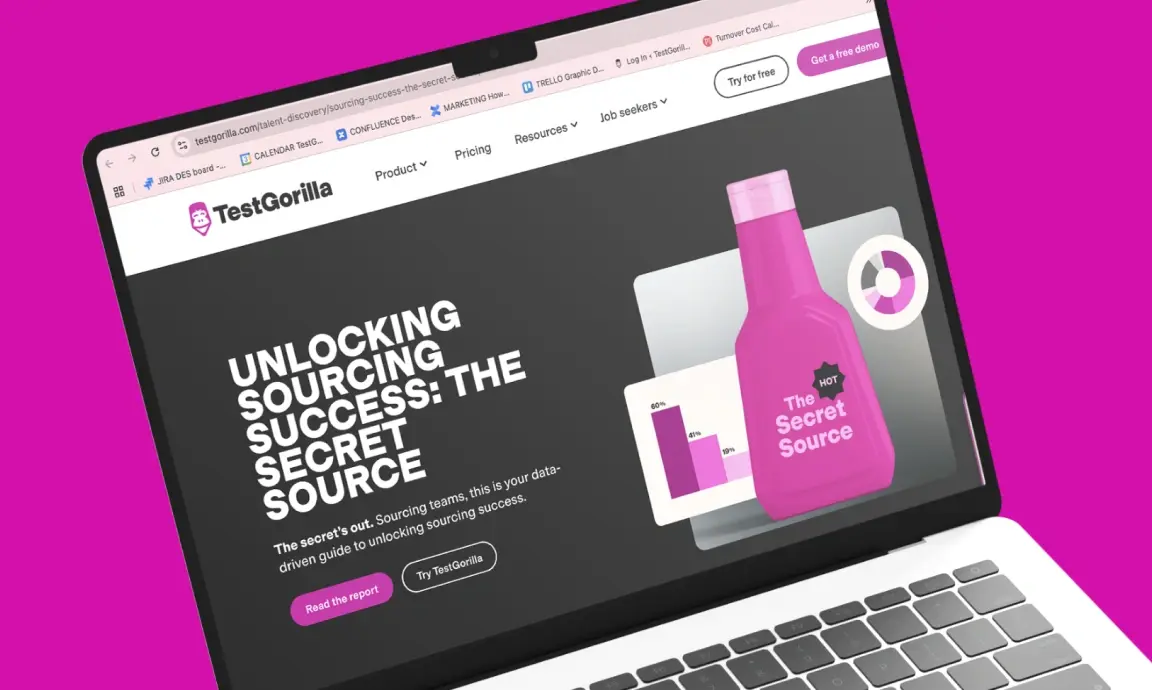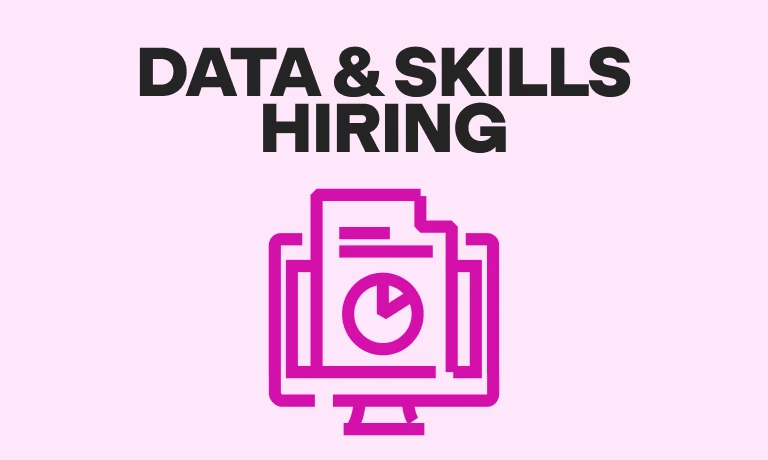Skills-based hiring is the key to hiring Agile teams – here’s why
An unstoppable change in our ways of working is well underway. It involves self-organizing teams who can proficiently complete work without supervision or bureaucracy. These teams work in short cycles and constantly respond to data about their customer’s needs. They are innovative, they experiment, and they pivot in response to changes in available technologies and market conditions. Fundamentally, they are Agile.
Since its birth in 200, midwifed by a group of 17 rebellious software developers in Utah, Agile thinking has been applied and operationalized throughout different industries. It has revolutionized IT in the last 20-odd years, improving productivity, quality, and speed to market in software development.
But its methodologies are increasingly being picked up and successfully leveraged outside of software development. The consensus now is that Agile’s mindset can be applied to pretty much anything. This mindset involves a series of shifts; from processes and tools to people, from excessive documentation to working prototypes, from following a plan to responding to change, and from rigid contracts to customer collaboration.
A meaningful implementation of Agile explodes the meaning of job descriptions as we know them. Teams become cross-functional, hierarchies disappear, and employees become dynamic, working on different projects according to where their skills are needed.
For this reason, becoming Agile requires a new approach to hiring. Agile hiring prioritizes skills over qualifications, background, and experience; and asks, what can this candidate add? rather than, does this candidate fit?
By hiring for skills, employers can prepare for the dexterity that Agile demands.
In this article, we’ll explain why skills-based hiring is the key to building truly Agile teams.
What exactly is Agile?
Agile’s origin story
Before Agile, software was predominantly built using a “Waterfall” approach. Someone would decide what kind of software they wanted to build, and a long, detailed requirements document would be written out before so much as a line of code was written. After flowing through all stages of the production process and its respective teams, an entire new piece of software was delivered.
The thing is, only testing outputs at the end of a project can be fatal. If you catch a bug at this phase, a lot of hard work has to be unraveled in order to fix it. Additionally, doing all the planning upfront reduces workers to mere cogs in a production wheel. As Scrum co-founder Ken Schwaber explained to The Atlantic, “[Waterfall] ruined our profession… It made it so people were viewed as resources rather than valuable participants.”
Because you can build better products when you’re able to test components and change specifications and designs according to customer feedback, this methodology lost favor. Leaders, founders, and thinkers in software development started pushing back, culminating in 2001 when 17 of them met in Utah for a skiing retreat. Over three days, they coined the Agile Manifesto.
The Agile manifesto
The Agile Manifesto is a document, hosted online, that outlines a new methodology for developing software. It has four core values:
Individuals and interactions over processes and tools
Working software over comprehensive documentation
Customer collaboration over contract negotiation
Responding to change over following a plan
It concludes that “while there is value in the items on the right, we value the items on the left more.” 12 principles support this manifesto; we won’t go into these, but they reiterate the importance of customer-centric iteration, reflection, and adjustment, as well as self-organization and openness to change.
Beyond software development
The global veneration and adoption of the Agile Manifesto, which has by now been translated into 60 different languages, has ushered in a host of profession-specific iterations of the document. Online you can find an Agile Product Manifesto, an Agile Sales Manifesto, an Agile Marketing Manifesto, an Agile Design Manifesto, and even an Agile Leadership Manifesto.
Alistair Cockburn, another of the 17 founding developers who met in Utah in 2001, has said that what Agile “managed to decode was something about pure, mental, team-based activities… It’s just an accident of history that it was programmers who decoded this.”
For Alistair, its near-universal applicability isn’t surprising. And neither are its results.
The positive impact of Agile for those companies using it to build software is notable. In statistics:
At least 71% of US companies are now using Agile
Agile projects are nearly 1.5 times more successful than waterfall ones
Agile teams are 25% more productive and 50% faster to market than non-agile ones
Only 9% of Agile projects fail
It’s interesting to note that Agile’s adoption has been accelerated by the pandemic. Digital.ai’s 16th State of Agile Report (2022) found that Agile adoption doubled for non-IT teams in the face of unpredictable and volatile work. Clearly, companies recognize the value of Agile methodologies in a hybrid work landscape.
One of the first studies to examine the effect of agile leadership on career success and job embeddedness showed that healthcare managers, who faced especially critical challenges during the pandemic, were more successful if they had high levels of agility. Agile leaders used strategies such as group decision-making, problem-solving, effective communication, and adaptation to uncertain environments to manage healthcare organizations efficiently during Covid-19.
This is to say, as well as creating efficient teams, Agile is also creating efficient leaders. Its influence really is hard to underestimate.
“By taking people out of their functional silos and putting them in self-managed and customer-focused multidisciplinary teams, the agile approach is not only accelerating profitable growth but also helping to create a new generation of skilled managers.” – Darrell Rigby, Jeff Sutherland, and Hirotaka Takeuchi (2016)
A recap on skills-based hiring
If you’re not new to TestGorilla, you’ve likely read a bit about skills-based hiring before. Frankly, we never shut up about it. But just in case you are, here’s a quick rundown on what skills-based hiring is and why we need it.
Skills-based hiring refers to any recruitment process that focusses, first and foremost, on skills and competencies rather than formal qualifications or employment background.
Employers who use skills-based hiring set specific skill or competency requirements for their open roles, and use talent assessments at the top of the recruitment funnel to identify top candidates according to these requirements.
A talent assessment is made up of tests that evaluate applicants’ cognitive abilities, personality, and role-specific skills. Along with top-of-the-funnel testing approach, multi-measure testing is key to using skills-based hiring effectively.
It’s also important to clarify how skills are defined in this context, since there can be the misconception that skills-based hiring is overly focussed on hard skills and fails to accommodate soft skills (which are just as important but harder to test for). This definition of skills from Deliotte is helpful:
“We broadly define “skills” to encompass “hard” or technical skills (such as coding, data analysis, and accounting); human capabilities or human skills (such as critical thinking and emotional intelligence); and potential (including latent qualities, abilities, or adjacent skills that may be developed and lead to future success). Eventually, we see the word “skills” becoming short-hand for more granularly defining workers as unique, whole individuals – each with an array of skills, interests, passions, motivations, work or cultural styles, location preferences and needs, and more.”
Hiring in this way (with a data-driven focus on technical skills, human capabilities, and potential) has manifold benefits for both employers, who can quickly identify top talent and avoid costly mis-hires, and candidates, who escape the bias that creeps into resume-based hiring and are evaluated as whole individuals.
To put this into numbers, our data shows that using skills-based hiring improves performance across five key areas. Of the companies using skills-based hiring:
89.8% reduced cost-to-hire
91.4% reduced time-to-hire
92.5% reduced mis-hires
91.2% increased retention
91.1% increased diversity
This data, collected from over 5,000 respondents, suggests that employers save time and resources with skills-based hiring, whilst employees are happier – their background is no longer an obstacle to employment, and they are less likely to want to leave.
The skills-based organization
But what does skills-based hiring have to do with Agile?In order to understand this, we first need to discuss what happens when you take skills-based practices beyond hiring. Because when the philosophy of skills-based hiring is applied internally and taken to its fullest realization, a whole new operating model for work emerges that places skills, over jobs, at the center. Roles become a fluid collection of skills, rather than rigid “jobs” with a set segment of responsibilities.
“People can be freed from being defined by their jobs and instead be seen as whole individuals with skills and capabilities that can be fluidly deployed to work matching their interests, as well as to evolving business priorities. And by basing people decisions on skills more than jobs, organizations can still have a scalable, manageable, and more equitable way of operating. We call this new operating model for work and the workforce ‘the skills-based organization.’” – From “The skills-based organization”, Deloitte (2022)
A shift like this radically changes the organization as a whole. Deloitte is calling it the skills-based organization, and is even hailing “the end of jobs” – its research reveals that only 19% of executives and 23% of workers say work is best structured through jobs. Tellingly, a “need for agility” is listed as one of the four big drivers of this shift. Most notably, their data reveals that skills-based approaches improve agility significantly: “A skills-based approach improves organizational agility by enabling workers to be quickly deployed—or redeployed—based solely on their skills and the work that needs to be done, irrespective of their job title or functional area. Organizations with a skills-based approach are 57% more likely to be agile.”As Deloitte’s piece on the skills-based operating model elaborates, work is atomized “into projects or tasks, or [broadened] so it’s focused on problems to be solved, outcomes to be achieved, or value to be created.” Sounds pretty Agile, right?
The best insights on HR and recruitment, delivered to your inbox.
Biweekly updates. No spam. Unsubscribe any time.
Skills-based organizations are 57% more likely to be Agile
So there you have it. Skills-based organizations are 57% more likely to be Agile, and skills-based organizations need skills-based hiring. The logic that follows? Skills-based hiring is the best possible way to build Agile teams – it’s the ultimate Agile hiring strategy.Although skills-based hiring doesn’t have Agile’s canonical origin story, its potential is just as revolutionary. It’s catching on, with 76% of businesses using skills-based hiring in some capacity in 2022, and it’s here to stay. Like Agile, skills-based hiring and skills-based organizations are here to change the world of work for the better – we’re certain of it. It’s no coincidence that the two go hand-in-hand.
Skills-based hiring 🤝 Agile hiring
Skills-based hiring is Agile hiring. If you’re looking to build Agile teams from scratch or even to increase the agility of your existing workforce, then our talent assessments can help you understand the skillsets of your existing and prospective employees. We even have a leadership test that’s designed to help you assess agility in leadership.To further feed your curiosity about skills-based hiring: Did you know that skills-based hiring can help close the gender application gap? It’s also the key to attracting and retaining talent during the Great Reshuffle. If you want to learn more, check out our blog. You can book a demo with us or try our free plan to see what the buzz is all about – we’d love to meet you.
Related posts
You've scrolled this far
Why not try TestGorilla for free, and see what happens when you put skills first.





















